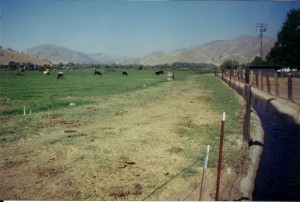When Rob and Sissi Morton moved into their Lemon Cove home 12 years ago, they thought they had bought a little piece of heaven. Their 1.5 acres of land had a beautiful view of the foothills and the Sierra Nevada Mountains. Regardless of the amount of rainfall, they also had some of the most reliable water in the state, with the water table only five feet down.

began.
That all changed when CEMEX came to town. In September 2002, the Tulare County Board of Supervisors (BOS) approved a mining permit for CEMEX to lease 496 acres of Donald and David Stillwell’s property. The name stuck and the mine became the Stillwell Quarry. A 137-acre portion in the middle of the parcel was to be mined for gravel. A condition of CEMEX’ permit was to construct a recharge trench and continually keep it full of water. This trench was to counteract the effects of CEMEX’ digging into the aquifer for gravel and disrupting the water flow to residents’ wells. The Morton’s, Rodriguez’, Clouds’ and Josh Packard’s homes border the Stillwell Quarry.
In September of 2013, CEMEX stopped filling the recharge trench and by December of last year, the four residents’ wells went dry or nearly dry. Repeated requests by the four residents to the BOS to force CEMEX to refill the trench only resulted in several contradicting studies and finger pointing, but no water. After months of bad publicity, during which the company engaged in a losing battle to blame the drought, CEMEX abruptly and unexpectedly started filling the recharge trench. After three months of trying to refill the trench, only two houses of the four have water, the Mortons’ and the Rodriguez’. Josh Packard and Orville and Mary Cloud still do not have enough water to run a load of dishes or take a shower. When CEMEX decides to leave Tulare County and the recharge trench goes permanently dry, the four homes will be permanently without water.
The list of expenses incurred when each house lost water for 10 months varied by the size of the house, yard and family. The Mortons have an acre-and-a-half of lawn, landscaping and fruit trees, a two-bedroom home and two children. Their expenses ranged from having to replace their pump to hauling water to their home to trips to the laundromat and friends’ homes so the children could bathe. They spent over $7,000.

But more than the expense of dealing with a dry well was the pain and suffering experienced by Sissi, who has a chronic kidney disease. She needs daily peritoneal dialysis, which she does at home and requires clean water. The stress of providing clean water for his wife’s dialysis with a dry well was very emotionally and physically stressful.
The Rodriguezes have two children but a smaller parcel of land. Their expenses were around $4,000 for the ten months their well went dry. The other two homes spent approximately the same but still have dry wells.
The larger expense is the depreciation in value of the four homes. Not only did all four homes lose their reliable source of water, but they also lost their beautiful view of grazing fields, foothills and the Sierra Nevada Mountains.
Before CEMEX started producing gravel they built an 18-foot berm to shield the homes from the noise. CEMEX then decided to construct the recharge trench on top of the berm.
Mark Avedian, of Avedian Properties, said that a house would lose half of its value if it lost its view and did not have a reliable water source. Another realtor said that if a resident’s well goes dry it would cost at least $20,000 to dig a new well. But with the underground aquifer being sucked into the ponds created by the gravel mine pits, a new well, no matter how deep, may not produce water.
The Mortons’ home was recently appraised at $120,000. If the home value went down by half as a result of the Stillwell Quarry, that would mean a loss of $60,000. When including the out-of-pocket expenses, that would be a total of $67,000. The other three homes are on smaller plots and of differing ages and size, and range in appraisal between $60,000 and $80,000. The total losses for all three homes would be around $120,000.
A letter written September 29 by the Tulare County Farm Bureau states, in part, “…we believe CEMEX should be accountable for the damages done to people and property near the Stillwell plant site operations, and be compelled to make them whole.” When taking account of all of the damages done by the Stillwell Mine to the four homes, the total would be approximately $180,000.
The residents are considering taking legal action if Tulare County, which issued the permit, and CEMEX, which operates the mine, do not provide adequate compensation for their financial loss and pain and suffering.
